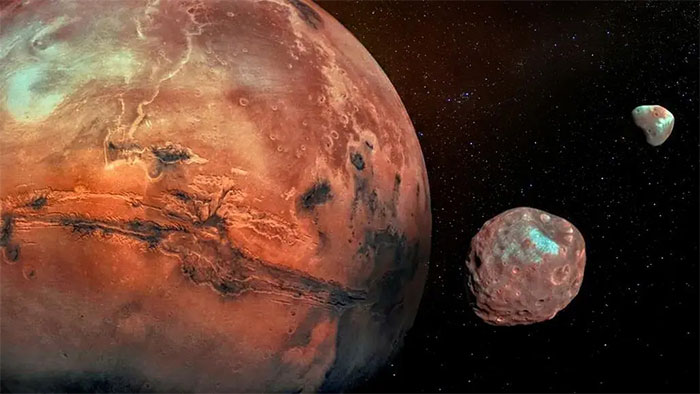Two 'invaders' from the edge of the Solar System are flying around Mars?
Unlike the satellite named Moon, which is part of the Earth, the two moons Phobos and Deimos of Mars have a very "dark" nature .
According to Live Science, a research team led by Professor Sonia Fornasier from Paris Cité University (France) analyzed a series of never-before-published images of the Mars Express probe spacecraft - European Space Agency Europe (ESA).
Those are 300 images that exquisitely capture the features of Phobos, the larger of the two moons of Mars.

The two Martian moons could be "invaders" from the edge of the Solar System - (Photo: NASA/BBC SKY AND NIGHT MAGAZINE).
Optical measurements suggest that Phobos's surface may be porous, sand-like, and devoid of atmosphere. In addition, the surface may be covered with a thick layer of oddly grooved dust particles, leading to uneven reflection of sunlight.
These properties are not like other Moons in the Solar System, but are similar to comets of the Jupiter family, which are comets whose orbits are governed by Jupiter's gravity.
In addition, previous studies also showed that Mars' Phobos does not have the same origin as Earth's Moon.
The moon is believed to have coalesced from debris from the collision between the early Earth and the hypothetical planet Theia, thus having a similar composition to the current Earth. But Phobos's composition is completely different from its parent planet , so it is a "abducted moon" . And in the most plausible scenario, Phobos must be a comet disguised as the Moon.
These findings also have implications for Deimos. If Phobos was a comet, then Deimos could also be a comet.
In fact, the authors believe that the 2 Moons may have once been a single comet consisting of 2 different large and small lobes, torn apart by Mars, then stuck in orbit and becoming the Sun. moon of this planet.
The Martian moons are said to have a "dark" origin because most comets in the solar system come from the Kuiper Belt or the Oort Cloud, which are distant structures at the murky edges of the star system.
This finding still needs a final confirmation. Fortunately, Japan's MMX spacecraft - scheduled to be launched this year in a cooperative mission with NASA - will head to Phobos and Deimos to collect samples, promising to bring back interesting answers.
- NASA Voyager 1 spacecraft comes to the edge of the solar system
- Beautiful photo from the Solar System
- Learn the secret of Mars formation
- Discovering the undiscovered '10th Planet' in the Solar System?
- The Solar System has never been this beautiful
- Will the Solar System have 9 planets again thanks to this new discovery?
- American spacecraft reaches the edge of the solar system
- The explorer Mars had trouble
- NASA has just taken a monstrous photo that looks like a fake about Mars
- Mysteriously the giant wall of the solar system was discovered by NASA
- What would happen if Mars and Earth switched places in the Solar System?
- People are about to leave the Solar System
 Announced 3 houses on the Moon and Mars
Announced 3 houses on the Moon and Mars Science proves: Mars also knows 'deflated'
Science proves: Mars also knows 'deflated' Elon Musk announced the price for a Mars trip was 11.6 billion VND, free of charge
Elon Musk announced the price for a Mars trip was 11.6 billion VND, free of charge NASA discovered strange 'gate' on Mars, is the hiding place found?
NASA discovered strange 'gate' on Mars, is the hiding place found?